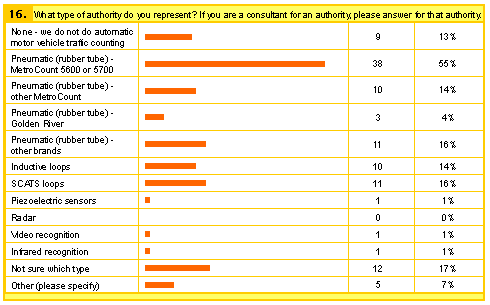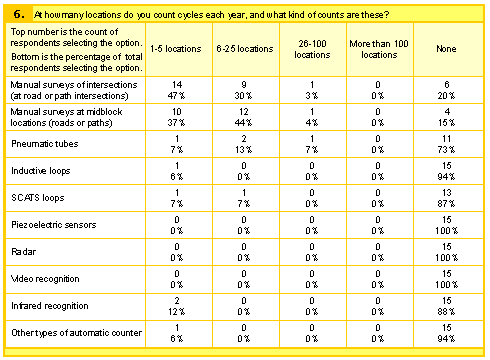
The objective of the survey was to establish the extent to which road controlling authorities (RCAs) (ie local councils and Transit New Zealand offices) and regional councils were counting cycles. A variety of questions sought to establish whether these agencies were counting cycle traffic manually or automatically, amongst other things.
A commercially available online survey package called Zoomerang was used. This was seen as an effective way to reach the agencies whose practices and views were sought, and to analyse the results.
A group of 12 practitioners was asked to complete a pilot survey before the main survey to ensure that the survey was clear and simple to use. Comments from the pilot survey were then used to refine the main survey.
The main survey was emailed to 83 councils (district, city and regional) and nine Transit offices. Land Transport NZ generated the address list from its contacts through regional offices. Invited participants were typically roading asset managers from local authorities and Transit's regionally based ‘cycling champions’. Each practitioner was invited to undertake the survey and was advised that it would take approximately 10 minutes to complete. If organisations did not count cycle traffic, various questions were able to be ‘skipped’ and the survey took less time. Several follow-up emails were sent to encourage participation in the survey. The survey is attached as appendix 2. The breakdown of survey recipients and response rates is shown in table 2.
Table 2 - Survey recipients and response rates
| Invited to respond | Responses received | Response rate | |
|---|---|---|---|
| City councils | 16 | 16 | 100% |
| District councils | 57 | 42 | 74% |
| Regional councils | 10 | 8 | 80% |
| Transit offices | 9 | 5 | 56% |
| Total | 92 | 71 | 77% |
Of the 92 agencies invited to participate, 71 surveys were completed, representing a response rate of 77 percent. A late response was received from one Transit office, effectively pushing Transit's response rate up to 67 percent (from the 56 percent shown in table 2) and the overall response rate up to 78 percent, although the data were not able to be used in the analysis. Overall trends, patterns and conclusions are not affected by this additional response.
Of the 71 organisations that responded to the survey, 59 percent were district councils, 23 percent were city councils, 11 percent were regional councils and 7 percent were from Transit offices.

Of those organisations that responded to the survey, 36 (51 percent) do not count cycle traffic, while 35 (49 percent) do. Of the 35 organisations that do count cycle traffic, 22 (31 percent of all respondents) use only manual counts (people physically counting cyclists, typically at intersections), while 11 (15 percent) use both manual counts and automatic methods.

A cross-tabulation of questions 1 and 17 revealed that, of the 36 agencies that do not count cycle traffic, only one was a city council. City councils are not only likely to count cycle traffic, but are more likely to use both manual and automatic methods.
Most district councils (67 percent) and regional councils (75 percent) do not count cycle traffic, while most city councils (94 percent) and Transit offices that responded to the survey (80 percent) do. District and regional councils and Transit offices that count cycles are more likely to do manual counts than automatics. The results of this cross-tabulation are shown in table 3.
Table 3 - Experience counting cycle traffic by agency type
| No. of responses | Manual | Automatic | Both | None | |
|---|---|---|---|---|---|
| City councils | 16 | 5 | 0 | 10 | 1 (6%) |
| District councils | 42 | 12 | 2 | 0 | 28 (67%) |
| Regional councils | 8 | 2 | 0 | 0 | 6 (75%) |
| Transit offices | 5 | 3 | 0 | 1 | 1 (20%) |
| Total | 71 | 22 | 2 | 11 | 36 |
Thus, all but one of New Zealand's 16 city councils count cycle traffic, while most of the district and regional councils do not. It is reasonable to assume that most of the councils and Transit offices that did not respond to the survey do not count cycle traffic.
Of all respondents to this survey, 66 percent have cycle infrastructure projects in either their longterm council community plan (LTCCP) or their 10-year State Highway plan.

From a cross-tabulation of questions 15 and 17, it has been determined that most city councils (93 percent of the 15 that responded to this question) have cycle infrastructure projects in their LTCCP, while 63 percent of district councils and 13 percent of regional authorities do. All Transit offices that responded also have cycle infrastructure projects in their 10-year State Highway plans. These results are shown in table 4.
Table 4 - Cycle projects in forward works programmes, by agency type
| No. of responses | Contain cycle projects in LTCCP or 10-year SH plan | Percentage | |
|---|---|---|---|
| City councils | 14 | 13 | 93% |
| District councils | 41 | 26 | 63% |
| Regional councils | 8 | 1 | 13% |
| Transit offices | 5 | 5 | 100% |
| Total | 69 | 45 | 65% |
The majority (62, or 87 percent) of the 71 agencies that responded to this survey count motor vehicle traffic automatically. Some use more than one technology. The most popular technology is MetroCount models 5600 or 5700 (pneumatic tube counters), accounting for 55 percent of respondents. Other kinds of rubber tube counters are used by 34 percent of respondents. Inductive and SCATS loops are also used.
Only nine respondents do not count motor vehicles: three district councils and six regional councils.

Of the 35 agencies that do not count cycle traffic and that responded to this question, 18 (over half) use MetroCount 5600 or 5700 counters to count motor vehicle traffic. These machines are the most commonly used counters for cycle traffic, so if these agencies wished to count cycle traffic, it would be relatively easy for them to do so. In addition, another 12 agencies count cycles manually (but not automatically), yet use these counters for motor vehicles. These agencies too have the potential to count cycle traffic automatically. Probably all they need is some encouragement on the key techniques and some special bicycle counting tubes (slightly softer than regular motor vehicle counting tubes).
Most agencies (22, or 67 percent) that count cycle traffic have done so for three years or less. However, four organisations have been counting cycle traffic for more than 10 years.

Of the 35 agencies that count cycle traffic, only four (11 percent) do not count cycle traffic manually. The majority (27, or 77 percent) of agencies that count cycles use external staff (such as contractors or students) for manual counts, as opposed to four (11 percent) who count traffic manually using their own staff.

Automatic cycle counting is carried out by only 11 agencies, or one-third of the agencies that responded to this question. Of these, seven use external contractors and four use their own staff.

Of those agencies that count cycle traffic, about half do ‘before and after’ cycle counts in association with installing new cycle facilities, and half do not.

Respondents seemed to have some difficulty with question 6 (the most complex question in the survey):
Of the 30 agencies that responded to the question about manual intersection surveys, 14 (47 percent) count 1–5 locations per year, nine (30 percent) count 6–25 locations and one (3 percent) counts 26–100 locations per year. Some 20 percent of respondents to this sub-question do not do manual intersection cycle counts.
Of the 27 agencies that responded to the question about manual mid-block surveys, 10 (37 percent) count 1–5 locations per year, 12 (44 percent) count 6–25 locations and one (4 percent) counts 26–100 locations per year. Some 15 percent of respondents to this subquestion do not do manual mid-block cycle counts.

Relatively few agencies use any of the automatic counting technologies, although pneumatic tubes (such as the MetroCount machines) are used by four agencies. Even fewer agencies are using inductive loops (1), SCATS loops (2) and infrared recognition (2), while no agencies reported using piezoelectric, radar or video recognition technology.
Five agencies claimed to count cycle traffic continuously. On further follow-up, it was determined that Queenstown Lakes District Council is currently successfully using radio beam counters to count cyclists and pedestrians on off-road paths. None of the others is counting traffic continuously, although two (Christchurch City Council, Palmerston North City Council) have extracted continuous counts from traffic signal loops for extended periods of time.

New technologies are being considered by nine agencies that currently count cycle traffic (26 percent). The technologies being considered include upright inductive loops, video technology and piezoelectric counters.

Of the 10 agencies that replied in the affirmative to this question, seven use MetroCount 5600 or 5700 counters and two of the remaining three were unsure (and might use the same counter). These counters are also used by many agencies for counting motor vehicle traffic.

Of those organisations that count cycle traffic, 48 percent have a systematic programme in place, while 23 percent of those that do not are developing one. Manual counting is the most popular type of counting included in cycle counting programmes.

The most commonly used analysis tool for cycle counts is a spreadsheet, although 27 percent of respondents were unsure. Only 12 percent used software provided by the counting equipment supplier. Respondents were able to include more than one kind of analysis tool for this question.

Most organisations (19, or 56 percent) use spreadsheets to store their data. Only three organisations store their data in a RAMM database, while eight use hard copies and seven were not sure. Respondents were able to include more than one kind of data storage medium for this question.

Questions 14 and 15 were answered by respondents who do not currently count cycles. As expected, the majority (86 percent) do not have a systematic cycle counting programme. Two agencies (both regional authorities) are proposing to develop a systematic programme for cycle counting, while one (a district council) has a programme but doesn't count cycle traffic.

Of the 35 who do not currently undertake cycle counting and who answered this question, 15 (43 percent) are not considering doing so, eight (23 percent) are not sure and 12 (34 percent) are considering counting cycle traffic. Of those considering counting cycle traffic, most (eight) would use manual counts only, two would use automatics only and two would use both manuals and automatics.

The final question of the survey asked respondents for any additional comments. Thirty respondents chose to do so: 18 of those who currently count cycles and 12 of those who currently do not.
The large number of comments suggests that participants were interested in the survey and the subject area. Some of the counts were relatively minor (eg one respondent simply replied ‘no’, ie he had no additional comments to make), but most were substantive. All comments are recorded in appendix 4, along with responses to some of the issues raised. The following key points emerged:
It is recommended that this report be made available to survey respondents by email and on the Land Transport New Zealand website.